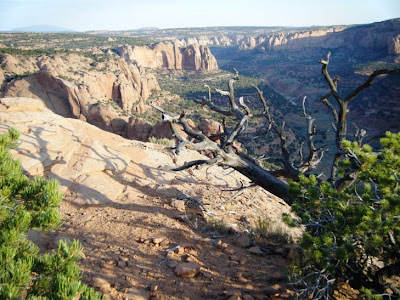
Welcome to Big Bend National Park! They say that everything is bigger in Texas, and let me tell you, this is one huge park! But despite its 801,163 acres, the park is ranked 15th in size in the National Park System. (Sorry Texas, your park isn't really bigger.) But even the littlest giant is still a giant, and this park had a lot to offer. However, probably because of its remote location, this park sees a relatively small number of visitors, typically between 300,000 and 400,000 per year.
Big Bend has desert plains, sub-alpine mountains, and 118 miles (189 km) of winding, muddy river banks along the Rio Grande. The diverse landscapes provides for a rich biological diversity. Behind me in the photo above along the north access road is a sign warning of black bears and panthers. Fortunately, I didn't have any run-ins with the more-dangerous wildlife. :-)
I stayed overnight in Chisos Basin campsite, which was truly an ideal spot!

The Chisos Basin was beautiful, and it had the benefit of being at an elevation of 5401 feet (1664 meters). That means that when it's blistering hot in the rest of the park, it's only a bit warm in the basin. And that means it's the coolest place to (legally) camp out in the park, literally!

That notch in the mountain range is known as the Window. Go figure! With Big Bend being so remote, and with Chisos Basin being at a relatively high elevation, the stars at night were awesome! You could really see the Milky Way!

Driving out around Big Bend's 123 miles (197 km) of paved roads was always a delight.

Postcard anyone? :-) What a striking land! Our National Parks are a real treasure!

The rocky spires below are together called the Mule Ears. :-)

Volcanic rock, limestone, and yucca adorned this patch of ground.

I just loved the look of this rocky bluff, with all of its prominent layers. This is near the hot springs in the park. I was on a mission to find these elusive springs.

I never did find the hot springs. :-( But at the time, it was around 100 F (38 C) outside, and clearly very sunny. I opted for a refreshing dip in this nearby cool but shallow stream. Ohhhh, that felt gooooooood!

Hiking out the Chimneys trail, I found one of the local residents. This spider was enjoying a tasty grasshopper snack. I thought the neatest thing was that this spider had built a house for himself out of small twigs. Even spiders can appreciate a little shade in this desert environment.

The desert floor with the Chisos mountains in the background was a beautiful, if inhospitable view. I loved the tall, straggly arms of the ocotillo plant, which you can see on the left side of the photo.

This was such a cool rock! Just look at all of those layers! Those layers tell a story. Was this rock formed from the sediment of some ancient pond? Did it come from silt deposits along a river bed? And how did this rock get here in the middle of the desert? Geologists would have a field day in this park!

There it is, the Rio Grande. It's not look that grand at the moment. The park's boundary officially at the deepest channel in the river. So in this one photo you see two countries! The land really doesn't look all that different on the other side. ;-)

On the western end of the Santa Elena canyon, with an "easy" hiking trail to see such sights as this boulder chock full of fossilized shells. I say "easy" because that's what it says in the brochure. But I think that the massive flood they had in 2008 made access to this trail a little less easy. I had to ford a muddy and mucky, ~2 feet (0.61 m) deep river to get over there.

And here is the view looking out Santa Elena Canyon into Big Bend. On your left, you'll notice the United States. On your right, Mexico.

Towards the end of my visit, I took a very rewarding hike along the Lost Mine trail, which included such wonderful views as this outcropping, which I think is known as Casa Grande. (No relation to the previous post.)

Up at this elevation, the climate is more forgiving, and so the diversity of plant life explodes compared to the desert floor. That doesn't stop the cacti from moving in either!

Impressive, no? I think this is known as Juniper Canyon.

There is something revitalizing about being up among the mountain peaks. I feel, I feel, not so flat. :-)

Lovely flowers in bloom greeted me near this peak.

More of the luscious landscape...

The only large animal I saw in my visit was this deer, who had no problems traversing the steep terrain.

Just beautiful. I don't know why, but I didn't have big expectations for Big Bend. Happily, it turned out to be truly a great place to explore, and a place I wouldn't mind seeing again.

Here I am at the end of the Lost Mine trail. From this vista, you can see the lost mine, which is an adjacent mountain side. The mine itself was not much to see. That didn't bother me, because I was lost in the splendor of this view. Speaking of lost, it's time I get lost in my next adventure. See you then!

































